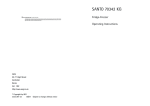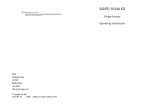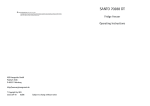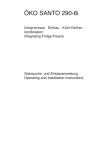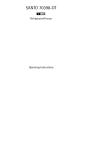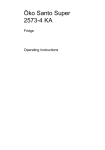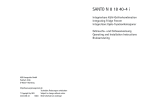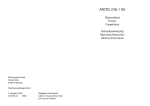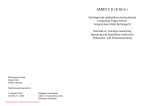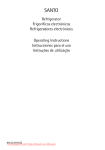Download Electrolux SANTO 72398-6 KA User manual
Transcript
SANTO 72398-6 KA User manual Electronic-Fridge Dear Customer Thank you for choosing one of our high-quality products. With this appliance you will experience the perfect combination of functional design and cutting edge technology. Our appliances are engineered to deliver the best performance and control - indeed we are setting the highest standards of excellence. In addition to this you will find environmental and energy saving aspects as an integral part of our products. To ensure optimal and regular performance of your appliance please read this instruction manual carefully. It will enable you to navigate all processes perfectly and most efficiently. To refer to this manual any time you need to, we recommend that you to keep it in a safe place, and please pass it to any future owner of the appliance. We wish you much joy with your new appliance. The following symbols are used in this manual Important information concerning your personal safety and information on how to avoid damaging the appliance General information and tips Environmental information 2 Contents Safety . . . . . . . . . . . . . . . . . . . . . . . . . . . . . . . . . . . . . . . . . . . . . . . . . .4 Disposal . . . . . . . . . . . . . . . . . . . . . . . . . . . . . . . . . . . . . . . . . . . . . . . .5 Appliance Packaging Information . . . . . . . . . . . . . . . . . . . . . . . . . . . . . .5 Disposal of old Appliances . . . . . . . . . . . . . . . . . . . . . . . . . . . . . . . . .5 Remove transport safeguard . . . . . . . . . . . . . . . . . . . . . . . . . . . . . . . .6 Fitting the Door Handle . . . . . . . . . . . . . . . . . . . . . . . . . . . . . . . . . . .7 Electrical connection . . . . . . . . . . . . . . . . . . . . . . . . . . . . . . . . . . . . . .8 Prior to Inital Start-up . . . . . . . . . . . . . . . . . . . . . . . . . . . . . . . . . . . .8 Control panel . . . . . . . . . . . . . . . . . . . . . . . . . . . . . . . . . . . . . . . . . . . .8 Starting up - setting the temperature . . . . . . . . . . . . . . . . . . . . . . . .9 Interior Accessories . . . . . . . . . . . . . . . . . . . . . . . . . . . . . . . . . . . . . .12 Storage shelves . . . . . . . . . . . . . . . . . . . . . . . . . . . . . . . . . . . . . . . . . . . . .12 Bottle Holder . . . . . . . . . . . . . . . . . . . . . . . . . . . . . . . . . . . . . . . . . . . . . . .12 Quick chill shelf . . . . . . . . . . . . . . . . . . . . . . . . . . . . . . . . . . . . . . . . . . . . .13 Bottle and Can Holder . . . . . . . . . . . . . . . . . . . . . . . . . . . . . . . . . . . . . . .13 Dismantling of the Bottle and Can Holder . . . . . . . . . . . . . . . . . . . . . .13 Door rack . . . . . . . . . . . . . . . . . . . . . . . . . . . . . . . . . . . . . . . . . . . . . . . . . .13 Installation of the carbon filter . . . . . . . . . . . . . . . . . . . . . . . . . . . . . . .14 Changing the carbon filter . . . . . . . . . . . . . . . . . . . . . . . . . . . . . . . . . . .14 Fresh food refrigeration . . . . . . . . . . . . . . . . . . . . . . . . . . . . . . . . . .15 Defrosting . . . . . . . . . . . . . . . . . . . . . . . . . . . . . . . . . . . . . . . . . . . . .15 Switching off the appliance . . . . . . . . . . . . . . . . . . . . . . . . . . . . . . .16 Cleaning and Care . . . . . . . . . . . . . . . . . . . . . . . . . . . . . . . . . . . . . . .16 Energy Saving Tips . . . . . . . . . . . . . . . . . . . . . . . . . . . . . . . . . . . . . . .17 What to do if . . . . . . . . . . . . . . . . . . . . . . . . . . . . . . . . . . . . . . . . . .18 Correcting Malfunctions . . . . . . . . . . . . . . . . . . . . . . . . . . . . . . . . . . . . .18 Changing the light bulb . . . . . . . . . . . . . . . . . . . . . . . . . . . . . . . . . . . . . .19 Service and Spare Parts . . . . . . . . . . . . . . . . . . . . . . . . . . . . . . . . . . . . . .20 Customer Care Department . . . . . . . . . . . . . . . . . . . . . . . . . . . . . . . . . .20 Guarantee Conditions . . . . . . . . . . . . . . . . . . . . . . . . . . . . . . . . . . . . . . .21 Installation - Electrical Connection . . . . . . . . . . . . . . . . . . . . . . . .22 Positioning . . . . . . . . . . . . . . . . . . . . . . . . . . . . . . . . . . . . . . . . . . . . .23 Rear spacer . . . . . . . . . . . . . . . . . . . . . . . . . . . . . . . . . . . . . . . . . . . . . . . . .23 Rehingeing the door . . . . . . . . . . . . . . . . . . . . . . . . . . . . . . . . . . . . . . . . .24 Regulations, Standards, Guidelines . . . . . . . . . . . . . . . . . . . . . . . . .26 3 Safety The safety aspects of our refrigerators/freezers comply with accepted technical standards and the German Appliance Safety Law. Nevertheless, we consider it our obligation to make you aware of the following safety information: Intended use • The refrigerator is intended for use in the home. It is suitable for cooling food. If the appliance is used for purposes other than those intended or used incorrectly, no liability can be accepted by the manufacturer for any damage that may be caused. • Alterations or changes to the freezer are not permitted for reasons of safety. • If you use the refrigerator in a commercial application or for purposes other than the cooling of foods, please observe all valid legal regulations for your application. Prior to initial start–up • Check the refrigerator for transport damage. Under no circumstance should a damaged appliance be plugged in! In the event of damage, please contact the retailer. Refrigerant The refrigerant isobutane (R600a) is contained within the refrigerant circuit of the appliance, a natural gas with a high level of environmental compatibility, which is nevertheless flammable. • During transportation and installation of the appliance, be certain that none of the components of the refrigerant circuit become damaged. • If the refrigerant circuit should become damaged: – avoid open flames and sources of ignition; – thoroughly ventilate the room in which the appliance is situated. Safety of children • Packaging (e.g. wraps, polystyrene) can be dangerous for children. There is a risk of suffocation! Keep packaging material away from children! • Please make old appliances unusable prior to disposal. Pull out the mains plug, cut off the mains cable, break or remove spring or boltcatches, if fitted. By doing this you ensure that children cannot lock themselves in the fridge when playing (there is risk of suffocation!)or get themselves into other dangerous situations. • This appliance is not intended for use by persons (including children) with reduced physical, sensory or mental capabilities, or lack of experience and knowledge, unless they have been given supervision or instruction concerning use of the appliance by a person responsible for their safety. 4 Children should be supervised to ensure that they do not play with the appliance. ! Daily Operation • Do not operate any electrical appliances in the refrigerator (e.g. electric ice cream makers, mixers etc.). • Before cleaning the appliance, always switch it off and unplug it, or pull the house fuse or switch off the circuit breaker. • When unplugging always pull the plug from the mains socket, do not pull on the cable. In case of malfunction • If a malfunction occurs on the appliance, please look first in the "What to do if ..." section of these instructions. If the information given there does not help, please do not perform any further repairs yourself. • Refrigerators/freezers may only be repaired by qualified service engineers. Improper repairs can give rise to significant hazards. If your appliance needs repairing, please contact your local Service Force Centre. Disposal Appliance Packaging Information All materials are environmentally sound! They can be dumped or burned at an incinerating plant without danger! About the materials: The plastics can be recycled and are identified as follows: >PE< for polyethylene, e.g. the outer covering and the bags in the interior. >PS< for polystyrene foam, e.g. the pads, which are all free of chlorofluorocarbon. The carton parts are made from recycled paper and should be disposed of at a waste-paper recycling collection location. Disposal of old Appliances For environmental reasons, refrigeration appliances must be disposed of properly. This applies to your old appliance, and - at the end of its service life - your new appliance as well. Warning! Before disposing of old appliances make them inoperable. Remove plug from mains, sever the power cable, remove or destroy any snap or latch closures. This eliminates the danger that playing children can lock themselves inside the appliance (danger of suffocation!) or place themselves in any other life-endangering situations. Disposal: • The appliance may not be disposed of with domestic waste or bulky refuse. • The refrigerant circuit, especially the heat exchanger at the back of the appliance, must not be damaged. 5 • The symbol on the product or on its packaging indicates that this product may not be treated as household waste. Instead it should be handed over to the appropriate collection point for the recycling of electrical and electronic equipment. By ensuring this product is disposed of correctly, you will help prevent potential negative consequences for the environment and human health, which could otherwise be caused by inappropriate waste handling of this product. For more detailed information about recycling of this product, please contact your local council, your household waste disposal service or the shop where you purchased the product. Remove transport safeguard The appliance and the interior fittings are protected for transport. •Remove all adhesive tape and packing pieces from the interior of the appliance. A Your appliance is equipped with shelf retainers that make it possible to secure the shelves during transportation. B To remove them proceed as follows: Move the shelf retainers in the direction of the arrow, raise the shelf C from the rear and push it forward until it is freed and remove the retainers. 6 Fitting the Door Handle 1. Screw the top handle bracket to the handle rod (1). Fit the bottom handle bracket on the lower lefthand side of the door (2). 2. Fit the top handle bracket on the top left-hand side of the door (3) and screw the handle rod to the bottom handle bracket (4). Attention! Do not overtighten the screws (max. 2 Nm) as you may damage the door handles. 7 Electrical connection Before initial start-up, refer to the appliance rating plate to ascertain if supply voltage and current values correspond with those of the mains at the installation location. e.g.: AC 230 ... 240 V 50 Hz or 230 ... 240 V~ 50 Hz (i.e. 230 to 240 volts alternating current, 50 Hertz) The rating plate is inside the appliance on the left. A correctly installed, earthed socket is required for the electrical supply. The supply must have a fuse rating of at least 10 Amps. If the socket is not accessible once the appliance is built in, the electrical installation must include suitable means of isolating the appliance from the mains (e.g. fuse, cut-out, current trip or similar with a minimum contact separation of 3 mm). Attention: it must be possible to disconnect the appliance from the mains power supply; the plug must therefore be easily accessible after the installation. Attention: If the supply cord is damaged, it must be replaced by a special cord or assembly available from the manufacturer or its Service Agent. Prior to Initial Start–Up • Please clean the appliance interior and all accessories prior to initial startup (see section: “Cleaning and Care”). Control panel A A. B. C. D. E. F 8 BC D E F Button ON/OFF Temperature setting button (for warmer temperatures) Temperature display Temperature setting button (for colder temperatures) COOLMATIC function and COOLMATIC indicator (yellow) ALARM OFF button and red warning light Temperature setting buttons • • The temperature is adjusted using the “B“ and “D“ buttons. These buttons are connected to the temperature display. The temperature display is switched over from the display of the ACTUAL temperature (Temperature display is illuminated) to the display of the DESIRED temperature (Temperature display flashes) by pressing one of the two buttons, “B“ or “D“ . Each time one of the two buttons is pressed again the DESIRED temperature is adjusted by 1 °C. The DESIRED temperature must be reached within 24 hours. If neither button is pressed, the temperature display automatically switches back after a short period (approx. 5 sec.) to the display of the ACTUAL temperature. DESIRED temperature means: The temperature that has been selected for inside the fridge. The DESIRED temperature is indicated by flashing numbers. ACTUAL temperature means: The temperature display indicates the current temperature inside the fridge. The ACTUAL temperature is indicated with illuminated numbers. Temperature display • • The temperature display can indicate several pieces of information. During normal operation, the temperature currently present in the fridge (ACTUAL temperature) is displayed. When the temperature is being adjusted a flashing display indicates the fridge temperature currently set (DESIRED temperature). ALARM OFF button With the ALARM OFF button, the acoustic warning signal can be switched off, e.g. the "Open Door" warning when loading or rearranging food to be chilled. Starting Up - Setting the Temperature 1. 2. 3. 4. Plug the mains plug into the mains socket. Press button (A). The appliance starts. Press either the “B“ or “D“ button. The temperature display switches over and the DESIRED temperature currently set flashes on the temperature display. Set the required temperature by pressing the “B“ or “D“ buttons (see section "Temperature setting buttons"). The temperature display will immediately show the changed setting. Each time the button is pressed the temperature 9 5. is adjusted by 1 °C. From a food safety point of view +5 °C should be considered sufficiently cold for storing food in the fridge. Once the required temperature has been set, after a short period (approx. 5 sec.) the temperature display will change and again indicate the current ACTUAL temperature inside the fridge. The display will change from flashing to continuous illumination. Information! When the setting is changed, the compressor does not start immediately if automatic defrosting is currently taking place. As the storage temperature within the fridge is reached quickly you can store food immediately after switching on. COOLMATIC 1. 2. The COOLMATIC function is suited for quick cooling of large quantities of goods in the refrigerator. The COOLMATIC function is switched on by pressing the COOLMATIC button. The yellow light illuminates. The COOLMATIC function now provides for intensive cooling. A DESIRED temperature of +2 °C is automatically selected. The COOLMATIC function is ended automatically after a period of 6 hours. The COOLMATIC function can be ended manually at any time by pressing the COOLMATIC button again. The yellow light goes out. QUICK CHILL The quick chill function can be used for the fast cooling of drinks in cans or bottles in the fast cool storage tray or of larger amounts of room-tempera ture food. The built-in charcoal filter reduces the development of any smell. Chilling of cans or bottles Place cans or bottles in the holder on the fast cool storage tray in front of the fan grille. Turn the fan regulator to maximum and press the MIN COOLMATIC button. The yellow MAX indicator light comes on. Chilling of food Place the food in the fridge. Open the fan regulator to maximum and press the COOLMATIC button. The yellow indicator light comes on. When the drinks or the food is sufficiently cooled, press the COOLMATIC button again. The yellow indicator light goes out. Set the fan regulator to the minimum position. 10 "Open Door"- Warning If the fridge door is left open for longer than 5 minutes the red warning display will flash and an acoustic warning tone will sound. If you need more time to load or rearrange refrigerated foods, you can switch off the warning tone by pressing the ALARM OFF button. The red warning display will go off when the door is closed. Holiday Mode In the holiday mode the temperature for the refrigerator is approximately +15 °C. In the holiday mode it is therefore possible to leave the door of the empty refrigerator closed during periods of extended absence. Advantage: Unintentional, or accidental closing of the door by persons who have access to your home during your absence, is no longer possible. Without activating the holiday mode, leaving the door closed would lead to the accumulation of odours and mould. After emptying and cleaning the appliance, proceed as follows: 1. To set the holiday mode, press the “ +” (WARMER) or “-“ (COLDER) button. The temperature display will change and indicate in flashing numbers the DESIRED temperature that is currently set. 2. Hold down the “+“ (WARMER) button until the temperature display indicates H (for holiday). The temperature shown in the temperature display will change in steps of 1 °C until it reaches +8 °C. After +8 °C the value +15 °C will appear in the display with the letter H. The fridge is now operating in energy-saving holiday mode. 3 To switch the fridge back to normal operation, press the “-“ (COLDER) button. Important! Do not store any goods in the refrigerator when the holiday mode is in operation. The temperature is regulated at about +15 °C when the holiday mode is in operation. This is too warm for food products. 11 Interior Accessories Storage shelves • You should always slide one of the full size glass storage shelf into the lowest set of guides, above the fruit and the vegetable containers, and keep it in this position. • The height of the storage shelves can be adjusted: • To do this pull the storage shelf forward until it can be swivelled upwards or downwards and removed. • Please do the same in reverse to insert the shelf at a different height. Slide the front half of the shelf in another level to the rear. To D338 gain space to place tall items on the storage shelf below. Adjusting the upper door rack Bottle holder Place the bottles (with the opening facing front) in the pre- positioned shelf. If the shelf is positioned horizontally, place only closed bottles. This bottle holder shelf can be tilted in order to store previously opened bottles. To do this, pull the shelf up so it can rotate upwards and be placed on the next higher level. 12 Quick Chill Shelf The quick chill shelf can be placed in the upper groove. Bottle and Can Holder The side of the bottle and can holder is moveable to enable a more flexible placement of cans and bottles in front of the grid. To allow the holder to be moved easier when moving sideways, press the shelf backwards. The bottle support can be pulled out when chilling larger bottles. Dismantling of the Bottle and Can Holder Take out the quick chill shelf with holder from the cabinet. To loosen the holder from the shelf, bend the hooks/brackets that surround the backside of the shelf. Depending on the food stored, the upper door racks can be changed to other holders or removed. Take out the food, press the door racks digonally upwards at their edges, reposition them, and press them back into place. 13 Installation of the carbon filter On delivery the carbon filter is placed in a plastic bag to secure the length of the carbon filter life. The filter should be placed behind the grill before the cabinet is turned on. The cover can be opened by turning the cover outward. The carbon filter is then mounted in the slot found in the back, see the illustration. 1 The filter should be handled carefully so fragments don´t loosen from the surface. Changing the carbon filter To maintain the best performance the carbon filter should be changed once a year with normal usage. New carbon filters can be purchased from your local dealer. The filter is placed behind the grill and can be reached by opening the cover. The cover can be opened by turning the cover outward The carbon filter is then pulled out of its slot . The new carbon filter is placed in the existing slot. The filter should be handled carefully so fragments do not loosen from the surface. 14 1 Fresh food refrigeration To obtain the best performance: • do not store warm food or evaporating liquid in the refrigerator • do cover or wrap the food, particularly if it has a strong flavour. • Position food so that air can circulate freely round it. Useful hints: Meat (all types): wrap in polythene bags and place on the glass shelf above the vegetable drawer(s)For safety, store in this way only one or two days at the most. Cooked foods, cold dishes, etc: these should be covered and may be placed on any shelf. Fruit and vegetables: these should be thoroughly cleaned and placed in the special drawer(s) provided. Butter and cheese: these should be placed in special airtight containers or wapped in aluminium foil or polythene bags to exclude as much air as possible. Milk bottles: these should have a cap and should be stored in the bottle rack in the door. Bananas, potatoes, onions and garlic, if not packed, must not be kept in the refrigerator. Defrosting Refrigerator Frost is automatically eliminated from the evaporator of the refrigerator compartment every time the motor compressor stops, during normal use. The defrost water drains out through a channel into a special container at the back of the appliance, over the motor compressor, where it evaporates. 15 Switching off the appliance 1. 2. 3. 4. 1. To switch off, press the ON/OFF button. This will result in a countdown from "3" to "1" taking place in the temperature display. On reaching "1" the fridge will switch off. The temperature display will go off. The appliance is only completely disconnected from the electricity supply when the power plug has been removed from the power outlet. Note: The appliance cannot be switched on or off if unplugged, or if there is no power being supplied to it. Following connection to the mains power supply, the appliance returns to the same operating state as before the interruption of main power. If the appliance is not going to be used for an extended period: Remove all refrigerated and deep-frozen packages as well as ice trays. Switch off the appliance by pressing the ON/OFF button (A). Remove the mains plug or switch off or turn out the circuit breaker or fuse. Leave the door open to avoid the build up of odours. Cleaning and Care For hygienic reasons the appliance interior, including interior accessories, should be cleaned regularly. Warning! • The appliance may not be connected to the mains during cleaning. Danger of electrical shock! Before cleaning switch the appliance off and remove the plug from the mains, or switch off or turn out the circuit breaker or fuse. • Never clean the appliance with a steam cleaner. Moisture could accumulate in electrical components, danger of electrical shock! Hot vapours can lead to the damage of plastic parts. • The appliance must be dry before it is switched back on. Attention! • Ethereal oils and organic solvents can attack plastic parts, e.g. – lemon juice or the juice from orange peals; – butyric acid; 16 1. 2. 3. 4. 5. 6. – cleansers which contain acetic acid. Do not allow such substances to come into contact with appliance parts. • Do not use any abrasive cleansers. Remove the food from the refrigerator. Switch the appliance off and remove the plug from the mains, or switch off or turn out the circuit breaker or fuse. Clean the appliance and the interior accessories with a cloth and lukewarm water. Commercially available dish washing detergents may also be used. After cleaning wipe with clean water and rub dry. Accumulation of dust at the condenser increases energy consumption. For this reason carefully clean the condenser at the back of the appliance once a year with a soft brush or a vacuum cleaner. Check the water drain hole on the rear wall of the fridge. Clear a blocked drain hole with the aid of the green peg in the pack of accessories included with the appliance. After everything is dry place appliance back into service. D037 Energy Saving Tips • Do not install the appliance near cookers, radiators or other sources of warmth. High ambient temperatures cause longer, more frequent operation of the compressor. • Ensure sufficient air circulation and exhaust at the appliance base and at the back wall of the appliance. Never cover air vent openings. • Do not place warm foods into the appliance. Allow warm foods to cool first. • Only leave door open as long as necessary. • Do not set temperature any colder than necessary. • Put frozen food in the fridge to defrost. The cold in the frozen food will then be used to cool the fridge. • Keep the heat emitting condenser and the metal grille on the rear wall of your appliance clean at all times. 17 What to do if ... Correcting Malfunctions A malfunction may be caused by only a minor fault that you can rectify yourself using the following instructions. Do not perform any other work on the appliance if the following information does not provide assistance in your specific case. Warning! Repairs to refrigerators/freezers may only be performed by qualified service engineers. Improper repairs can give rise to significant hazards for the user. If your appliance needs repairing, please contact your local Service Force Centre. Malfunction Possible Cause Remedy Appliance is not switched on Switch on the appliance. Mains plug is not plugged in Insert mains plug. or is loose. Appliance does not work. Check fuse, replace if Fuse has blown or is defective. necessary. Mains malfunctions are to be Socket is defective. corrected by an electrician. Turn the temperature Appliance cools too much. Temperature is set too cold. regulator to a warmer setting temporarily. Temperature is not properly Please look in the "Initial Start adjusted. Up" section. Door was open for an Open the door only as long as extended period. necessary. The food is too warm. A large quantity of warm food Turn the temperature was placed in the appliance regulator to a colder setting within the last 24 hours. temporarily. The appliance is near a heat Please look in the "Installation source. location" section. Interior lighting does not Please look in the "Changing Light bulb is defective. work. the Light Bulb" section. Carefully warm the leaking sections of the door seal with a hair dryer (not hotter than Door seal is not air tight Heavy build up of frost, (possibly after changing over approx. 50 °C). At the same possibly also on the door seal. time shape the warmed door the hinges). seal by hand such that it sits correctly. 18 Malfunction Possible Cause Appliance is not level. Remedy Readjust the feet. The appliance is touching the Move the appliance slightly. wall or other objects. Unusual noises. A component, e.g. a pipe, on If necessary, carefully bend the rear of the appliance is the component out of the touching another part of the way. appliance or the wall. The compressor does not start This is normal, no error has immediately after changing occurred. the temperature setting. The compressor starts after a period of time. Water on the floor or on storage shelves. See the "Cleaning and Care" section. Water drain hole is blocked. Changing the light bulb 1. 2. 3. 4. 5. 6. Warning! There is a risk of electric shocks! Before changing the light bulb, switch off the appliance and unplug it, or pull the fuse or the circuit breaker. Light bulb data: 220-240 V To switch off the appliance, push the button (A). Unplug the mains plug. To change the light bulb press on the rear hook and at the same time slide the cover in the direction indicated by the arrow. Change the defective light bulb with one of the some power (the maximum power is shown on the light diffuser). Refit the light bulb cover. Put the refrigerator back into operation. 19 Service and Spare Parts In the event of your appliance requiring service, or if you wish to purchase spare parts, please contact your local Service Force Centre by telephoning: 0870 5 929929 Your telephone call will be automatically routed to the Service Force Centre covering your post code area. For address of your local Service Force Centre and further information about Service Force, please visit the website at www.serviceforce.co.uk. Before calling out an engineer, please ensure you have read details under the heading “Something Not Working”. When you contact the Service Force Centre you will need to give following details: 1.Your name, address and post code 2.Your telephone number 3.Clear and concise details of the fault 4.The model and serial number of the apliance. (found on the rating plate). 5.The purchase date Please note that a valid purchase receipt or guarantee documentation is required for in-guarantee service calls. Customer Care Department For general enquiries concerning your AEG-Electrolux appliance or for futher information on AEG-Electrolux products, please contact our Customer Care Department by letter or telephone at the address below or visit our website at www.aeg-electrolux.co.uk. Customer Care Department AEG-Electrolux Major Appliances Addington Way Luton Bedfordshire LU4 9QQ Tel: 08705 350 350* *calls to this number may be recorded for training purposes 20 GUARANTEE CONDITIONS Standard guarantee conditions We, AEG-Electrolux, undertake that if within 12 months of the date of the purchase this AEG-Electrolux appliance or any part thereof is proved to be defective by reason only of faulty workmanship or materials, we will, at our discretion repair or replace the same FREE OF CHARGE for labour, materials or carriage on condition that: · The appliance has been correctly installed and used only on the electricity or gas supply stated on the rating plate. · The appliance has been used for normal domestic purposes only, and in accordance with the manufacturer's operating and maintenance instructions. · The appliance has not been serviced, maintained, repaired, taken apart or tampered with by any person not authorised by us. · All service work under this guarantee must be undertaken by a Service Force Centre. Any appliance or defective part replaced shall become the Company's property. · This guarantee is in addition to your statutory and other legal rights. · Home visits are made between 8.30am and 5.30pm Monday to Friday. Visits may be available outside these hours in which case a premium will be charged. Exclusions This guarantee does not cover: · Damage or calls resulting from transportation, improper use or neglect, the replacement of any light bulbs or removable parts of glass or plastic. · Costs incurred for calls to put right an appliance which is improperly installed or calls to appliances outside the United Kingdom. · Appliances found to be in use within a commercial environment, plus those which are subject to rental agreements. · Products of AEG-Electrolux manufacture which are not marketed by AEG-Electrolux. European Guarantee If you should move to another country within Europe then your guarantee moves with you to your new home subject to the following qualifications: · The guarantee starts from the date you first purchased your product. · The guarantee is for the same period and to the same extent for labour and parts as exists in the new country of use for this brand or range of products. · This guarantee relates to you and cannot be transferred to another user. · Your new home is within the European Community (EC) or European Free Trade Area. · The product is installed and used in accordance with our instructions and is only used domestically, i.e. a normal household. · The product is installed taking into account regulations in your new country. Before you move please contact your nearest Customer Care centre, listed below, to give them details of your new home. They will then ensure that the local Service Organisation is aware of your move and able to look after you and your appliances. France Senlis +33 (0)3 44 62 29 29 Germany Nürnberg +49 (0)800 234 7378 Italy Pordenone +39 (0)800 117511 Sweden Stockholm +46 (0)8 672 53 60 UK Luton +44 (0) 8705 350 350 21 Installation Electrical Connection Any electrical work required to install this appliance should be carried out by a qualified electrician or competent person. WARNING – THIS APPLIANCE MUST BE EARTHED The manufacturer declines any liability should these safety measures not be observed. Before switching on, make sure the electricity supply voltage is the same as that indicated on the appliance rating plate. The rating plate is inside, on the left. The appliance is supplied with a 13 amp plug fitted. In the event of having to change the fuse in the plug supplied, a 13 amp ASTA approved (BS 1362) fuse must be used. Important! GREEN & YELLOW 13 AMP. FUSE 13 AMP The wires in the mains lead are coloured in accordance with the following code: Green and Yellow Earth Blue Neutral Brown Live As the colours of the wires in the BROWN mains lead of this appliance may not BLUE CORD CLAMP correspond with the coloured D207 markings identifying the terminals in your plug, proceed as follows: The wire coloured green and yellow must be connected to the terminal marked with the letter “E” or by the earth symbol or coloured green and yellow. The wire coloured blue must be connected to the terminal marked “N” or coloured black. The wire coloured brown must be connected to the terminal marked “L” or coloured red. Upon completion there must be no cut, or stray strands of wire present and the cord clamp must be secure over the outer sheath. Warning! A cut-off plug inserted into a 13 amp socket is a serious safety (shock) hazard. Ensure that the cut-off plug is disposed of safely. 1. 2. 3. 4. 22 Positioning 10 mm 10 mm 100 mm This appliance should only be installed at a location where the ambient temperature corresponds to the climate classification indicated on the rating plate, which is located at the left on the inside of the appliance. The following table shows which ambient temperature is correct for each climate classification: SN +10°C to + 32°C N +16°C to + 32°C ST +18°C to + 38°C T +18°C to + 43°C For correct operation this appliance must be located in a dry atmosphere, away from heat sources, e.g. cookers, radiators, boilers and direct sunlight. You should also ensure that air can NP00 circulate freely around the back and the top of the cabinet. There should be 100mm (4”) between the top of the cabinet and any overhanging kitchen furniture. Alternatively allow 50mm (2”) between the top of the cabinet and any overhanging kitchen furniture and a gap of 25mm (1”) on either side of the appliance. Do not obstruct the space underneath. The back of the cabinet D200 may be placed close to the wall but must not touch it. DO NOT install in places with restricted ventilation. Adjust the level of the appliance by screwing out the adjustable foot, or feet, at the bottom of the cabinet using your fingers. Rear spacers Fit the rear spacers contained in the appliance to ensure escape of heat generated during operation. Proceed in the sequence illustrated in figures. 23 Re-hinging the door 1. 2. 3. 4. 5. 6. 7. 8. 24 The side at which the door opens can be changed from the right side (factory adjustment) to the left side, if the installation site requires. Warning! When changing the side at which the door opens, the appliance may not be connected to the mains. Remove plug from the mains beforehand. Procced as follows: To carry out the following operations, we suggest that this be done with another person that will keep a firm hold on the door of the appliance during the operations. Gently lay the appliance on its back. Remove the ventilation grille. Remove the bottom hinge (A) by unscrewing the fixing screws. Remove the door. Unscrew the pin of the bottom hinge (f) and refit it on the opposite side. Unscrew the pin of the upper hinge (d) and refit it on the opposite side. Insert the door in the upper hinge and refit the upper hinges (A). Pay attention that the border of the doors are parallel to the top border, otherwise adjust the position of the lower hinge of the door (A). Remove from the ventilation grille the cover (e) and refit it on the opposite side. Refit ventilation grille. 9. Unscrew the top handle bracket from the handle rod (1). Unscrew the bottom handle bracket from the door (2). Unscrew the top handle bracket from the door (3) and screw onto the bottom righthand side of the door (4). Turn the handle bracket with the handle rod 180° and screw them to the door (5) and the fitted handle bracket (6). Move the small plug from right to left.. Reposition, level the appliance, wait for at least one hour and then connect it to the mains socket. In any case you do not want to carry out the above mentioned operations, contact your local Sales Service Force. The Service engineer will carry out the reversibility of the doors at your cost. Attention: After having reversed the opening direction of the doors check that all the screws are properly tightened and that the magnetic seal adheres to the cabinet. If the ambient temperature is cold (i.e. in Winter), the gasket may not fit perfectly to the cabinet. in that case, wait for the natural fitting of the gasket or accelerate this process by heating up the part involved with a normal hairdryer. 25 Regulations, Standards, Guidelines This appliance was designed for household use and was manufactured in accordance with the appropriate standards. The necessary measures in accordance with appliance safety legislation regulations (GSG), accident prevention regulations for refrigeration appliances (VBG 20) and the regulations of the German Society of Electrical Engineers (VDE) were observed in the manufacture of this appliance. The refrigerant circuit has been checked for leaks. This appliance is in accordance with the following EU guidelines: – 73/23/EWG dated 19 February 1973 - low voltage guidelines. – 89/336/EWG dated 3 May 1989 (including guideline change notice 92/31/EWG) - EMV guideline 26 www.electrolux.com Subject to change without notice www.aeg-electrolux.co.uk 2223 421-54-00-17102008




























